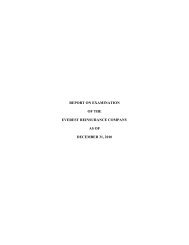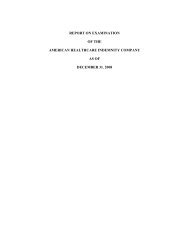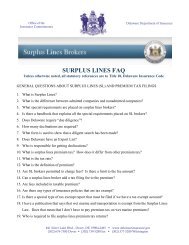Filing at a Glance General Information - Delaware Insurance ...
Filing at a Glance General Information - Delaware Insurance ...
Filing at a Glance General Information - Delaware Insurance ...
Create successful ePaper yourself
Turn your PDF publications into a flip-book with our unique Google optimized e-Paper software.
Loss Development<br />
ADJUSTMENTS TO LOSSES<br />
Attachment II<br />
Page 3<br />
As in past filings, accident year incurred losses are developed for the liability coverages, and<br />
accident year paid losses are developed for the physical damage coverages. Allst<strong>at</strong>e's standard<br />
loss development procedure is to select ultim<strong>at</strong>e accident year losses after analyzing estim<strong>at</strong>es<br />
developed using the Link R<strong>at</strong>io and Additive methods. Accident year incurred losses are<br />
developed for the liability coverages. Accident year paid losses are developed for the physical<br />
damage coverages.<br />
While the link r<strong>at</strong>io method assumes th<strong>at</strong> future development is proportional to losses th<strong>at</strong> have<br />
already emerged as of a given evalu<strong>at</strong>ion d<strong>at</strong>e, the additive method assumes th<strong>at</strong> future<br />
development is proportional to the number of earned exposures in the accident period, where the<br />
expected development per exposure is based on historical development p<strong>at</strong>terns per exposure<br />
adjusted to account for differences in frequency and severity over time. Allst<strong>at</strong>e believes the<br />
approach of considering two loss development procedures when estim<strong>at</strong>ing ultim<strong>at</strong>e losses better<br />
upholds the suggestion contained in the St<strong>at</strong>ement of Principles Regarding Property and Casualty<br />
Loss and Loss Adjustment Expense Reserves th<strong>at</strong> “Ordinarily the actuary will examine the<br />
indic<strong>at</strong>ions of more than one method when estim<strong>at</strong>ing the loss and loss adjustment expense<br />
liability for a specific group of claims.”<br />
To calcul<strong>at</strong>e estim<strong>at</strong>ed ultim<strong>at</strong>e losses using the Link R<strong>at</strong>io methods, historical age-to-age link<br />
r<strong>at</strong>ios are calcul<strong>at</strong>ed, which represent loss development between different evalu<strong>at</strong>ion periods. An<br />
average of the historical link r<strong>at</strong>ios is then used to estim<strong>at</strong>e the ultim<strong>at</strong>e level of paid losses to be<br />
used in r<strong>at</strong>emaking. This method assumes th<strong>at</strong> historical loss development p<strong>at</strong>terns can be used<br />
to estim<strong>at</strong>e future loss development on current imm<strong>at</strong>ure claims.<br />
For the Additive loss development method, historical losses are first trended to today’s price<br />
level using pure premium trends selected from Allst<strong>at</strong>e Indemnity Company d<strong>at</strong>a. This is done<br />
to avoid distortions due to changes in the underlying loss costs. Please note th<strong>at</strong> due to the<br />
different lengths of trend periods in each analysis, the selected pure premium trend th<strong>at</strong> is used in<br />
loss development often differs from the selected trend th<strong>at</strong> applies to the underlying d<strong>at</strong>a.<br />
Trended additive amounts per exposures are calcul<strong>at</strong>ed, which represent trended loss<br />
development between different evalu<strong>at</strong>ion periods. An average of the historical trended additive<br />
amount per exposure is then used to estim<strong>at</strong>e the ultim<strong>at</strong>e trended level of paid losses. Trended<br />
age-to-ultim<strong>at</strong>e additive amounts per exposure are multiplied by earned exposures for each<br />
accident year to calcul<strong>at</strong>e trended losses th<strong>at</strong> have yet to emerge. A final step in the Additive<br />
Method is to detrend the trended losses yet to emerge. Losses are detrended because the<br />
applic<strong>at</strong>ion of trend is accounted for in a separ<strong>at</strong>e step in the r<strong>at</strong>emaking process. This method<br />
assumes th<strong>at</strong> historical loss development p<strong>at</strong>terns per exposure can be used to estim<strong>at</strong>e future<br />
loss development on current imm<strong>at</strong>ure claims.<br />
Refer to Exhibits 3.1 through 4.6 of Attachment III for the loss development of each coverage<br />
using both the Link R<strong>at</strong>io and Additive Methods of loss development. A summary of the<br />
estim<strong>at</strong>ed ultim<strong>at</strong>e losses using each method as well as the selected ultim<strong>at</strong>e losses is shown on






